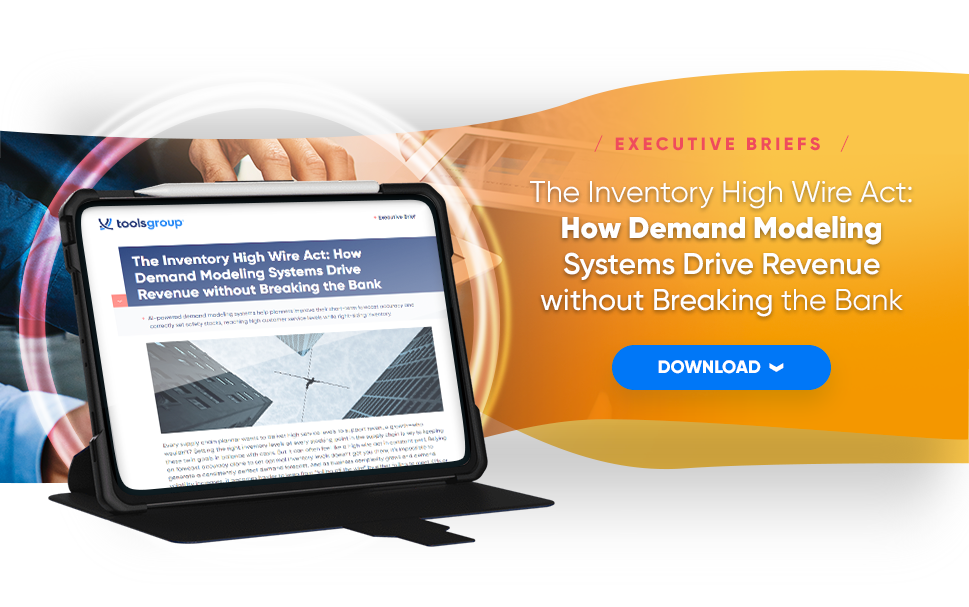Planning to Win: Optimizing Inventory to Meet Business Objectives
Who wouldn’t want their supply chain to be “optimized,” right?
Optimization is peak efficiency, using the perfect balance of inventory and resources to service customer demand without incurring any unnecessary costs or waste.
However, optimization is a term that’s often misunderstood and applied incorrectly in the supply chain world.
Even in a perfectly optimized supply chain, if you zoom in on a specific process, it may appear to be running sub-optimally.
Counterintuitive though it sounds, an optimized whole is not constructed with all parts running at full throttle. For one part of the system to contribute effectively to the overall goal, other parts must ‘ease up’.
Think of a crew competing in a yacht race.
As the skipper on the helm steers towards the finish, she doesn’t head the boat in an optimal straight line while each crew member ‘optimizes’ at their individual positions.
She must consider variables like wind direction, other boat traffic, and ocean current and depth, orchestrating her crew to ‘tack’ the boat in a zig zag fashion around the markers and towards the finish line.
With each tack, as crew members tightens their winches and the sails, others ease theirs off.
Since this is a race, the skipper’s goal is to optimize the crew and yacht to reach the finish line as fast as possible, crucially, while staying on the right side of the markers on the course so as not to be disqualified.
However, if this were a pleasure cruise with amateur sailors, the skipper’s goal would be totally different: perhaps to allow four hours of sightseeing before watching the sun go down.
She and her crew would reduce the sail area to slow the boat down, allowing the crew to serve cocktails and the guests move safely about the boat.
Optimizing is meaningless without an inventory optimization objective. The objective informs every trade-off decision in a system.
Different business objectives for different market conditions
Just as our skipper needed to keep the boat on course to avoid disqualification, a company’s survival depends on servicing demand at the right level.
For the business to thrive, then they need to optimize for a business objective, whether it’s revenue, profit margin, avoiding obsolescence, or another target.
In the current climate, with severe current supply constraints, many companies are interested in optimizing for margin.
In more buoyant times, more companies may be optimising for revenue to grab market share.
Our customer Granarolo is a great example of a company whose inventory optimization objectives are to minimize obsolescence and maximize the residual product shelf life. This is a common goal for food and beverage companies.
New mindsets, processes, and systems required
Of course, the inventory optimization process is infinitely more complex than yacht racing.
Most companies have large, complex SKU portfolios that include popular, fast-moving items, seasonal items, products with short lifecycles, and specialty items whose demand patterns are almost impossible to predict.
It’s difficult enough to meet service levels, never mind optimize for any other business goals.
That’s why so many manufacturers run on wafer-thin margins.
Fortunately, it’s possible not only to meet or exceed service levels (product availability), but also to meet business goals at the same time.
In fact, when our customers get this process right, their overall service levels go up by 3-5% as overall inventory levels decrease by 15-30%.
But this staggeringly complex multi-dimensional process can’t be optimized using old, manual tools and methods like spreadsheets, ABC classification, and ‘one number’ planning–never mind gut instinct.
To optimize inventory for a business objective, the old ABC classification method must be replaced with a new approach: inventory mix optimization.
Whereas ABC involves segmenting SKUs and assigning blanket inventory policies to them by logistics characteristics (e.g. cost per unit, quantify of stock) inventory mix optimization is a service-driven approach.
Learn More ⟶ ‘What’s Wrong with ABC Inventory Classification’
In inventory mix optimization, each SKU-Location is segmented into its own “service class.”
These classes are described using terms that are meaningful to sales and marketing, relating to the level of service they require, for example, ‘high-margin,’ ‘own-brands,’ ‘high-end brands,’ and ‘decorative spare parts.’
Each SKU-L then gets assigned a unique service level and inventory policy.
So if you’re aiming for an overall service level of 95%, you might assign high-end a 99% service level, while decorative spare parts may only require 50%.
Learn More ⟶ Optimizing Inventory Is About Improving Service While Lowering Inventory. Wait, What?
Automating inventory trade-offs empowers supply chain planners
To optimize your inventory mix to meet your business objectives, you must use an advanced planning system that automates these trade-offs.
The most sophisticated supply chain inventory optimization solutions also let planners set constraints on certain SKU-Ls when planning an inventory mix.
For example, if planners set an overall target of 95% service level, no item in the mix should go below 50%. They can set these constraints to single items or groups of items.
The right system should also put planners in the driver’s seat by allowing them to construct ‘what/if’ scenarios so they can see what happens when they set different service levels against business objectives.
It also helps retailers plan for demand, calculating optimal stock levels by taking into account consumer behaviors and supply variability.
From surviving to thriving
Yacht skippers have the benefit of a clear destination, can see and control all the variables, and can shout instructions to their entire crew at once.
Supply chain leaders aren’t so fortunate.
Optimizing supply chains admittedly takes a leap of faith.
It involves a staggering number of trade-offs, many of which are counterintuitive to human nature.
You need to put your trust in advanced systems whose workings you can’t constantly monitor, or even fully understand.
However, our customers are living proof that when you can overcome these obstacles your business can not only survive, but really thrive.







